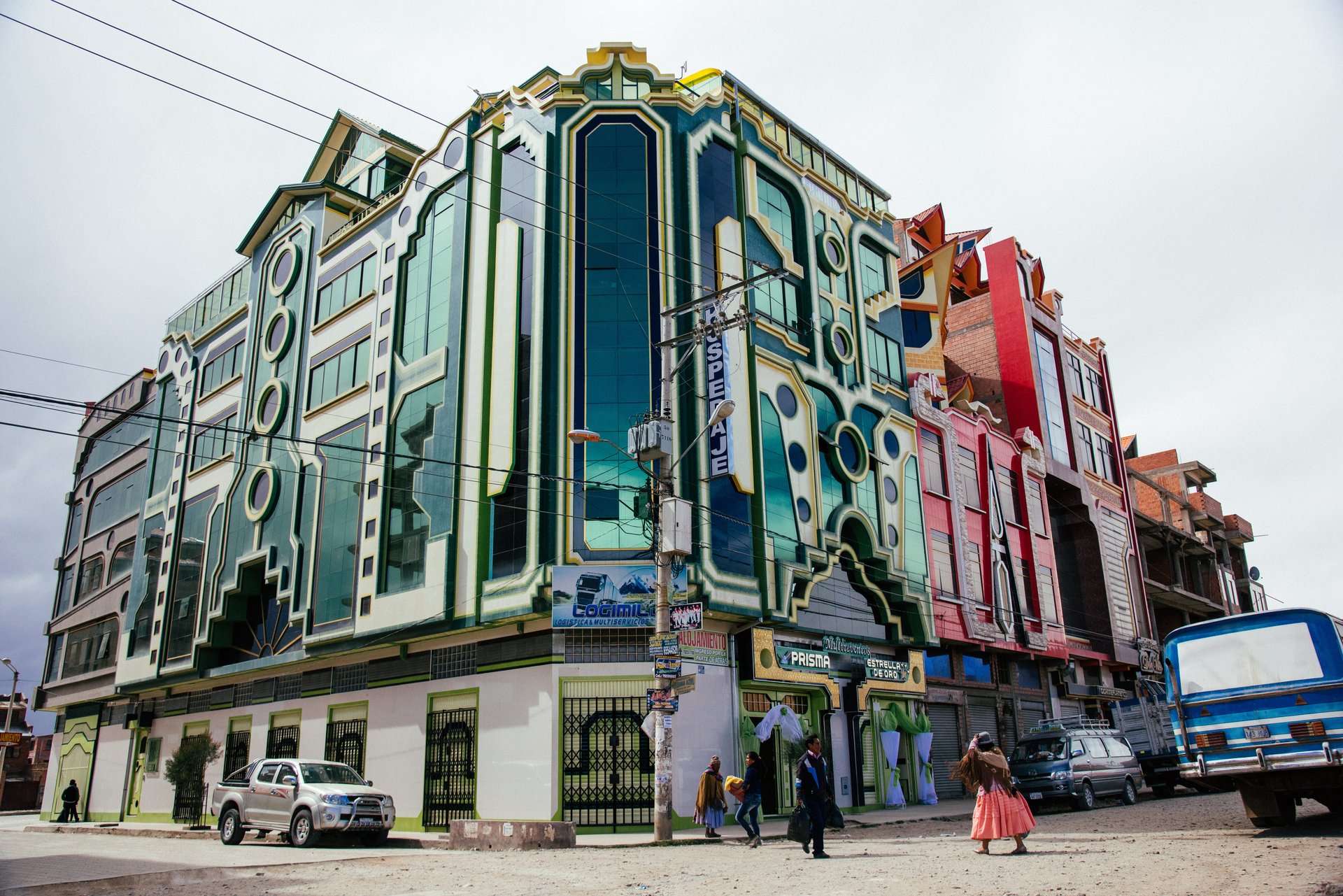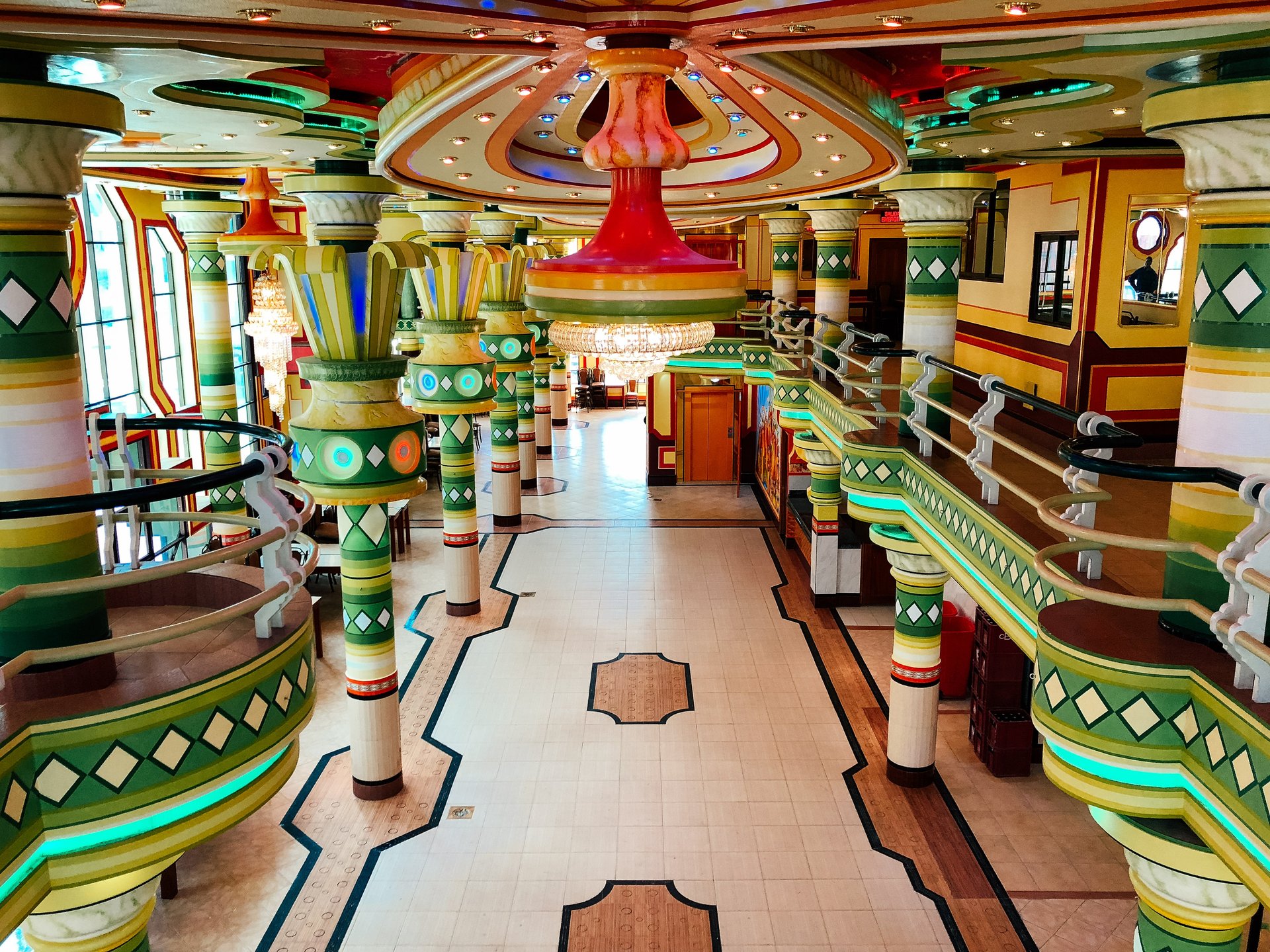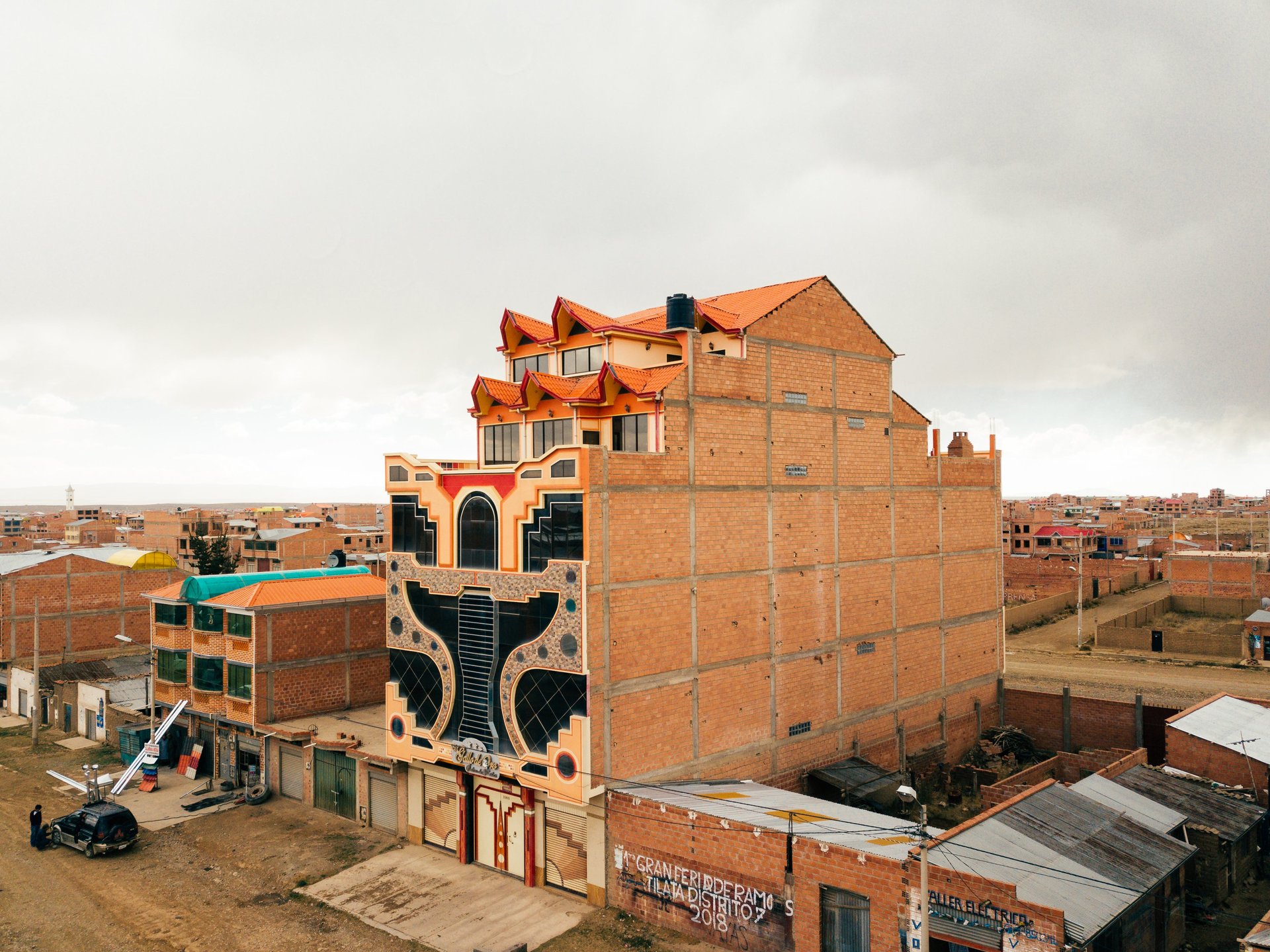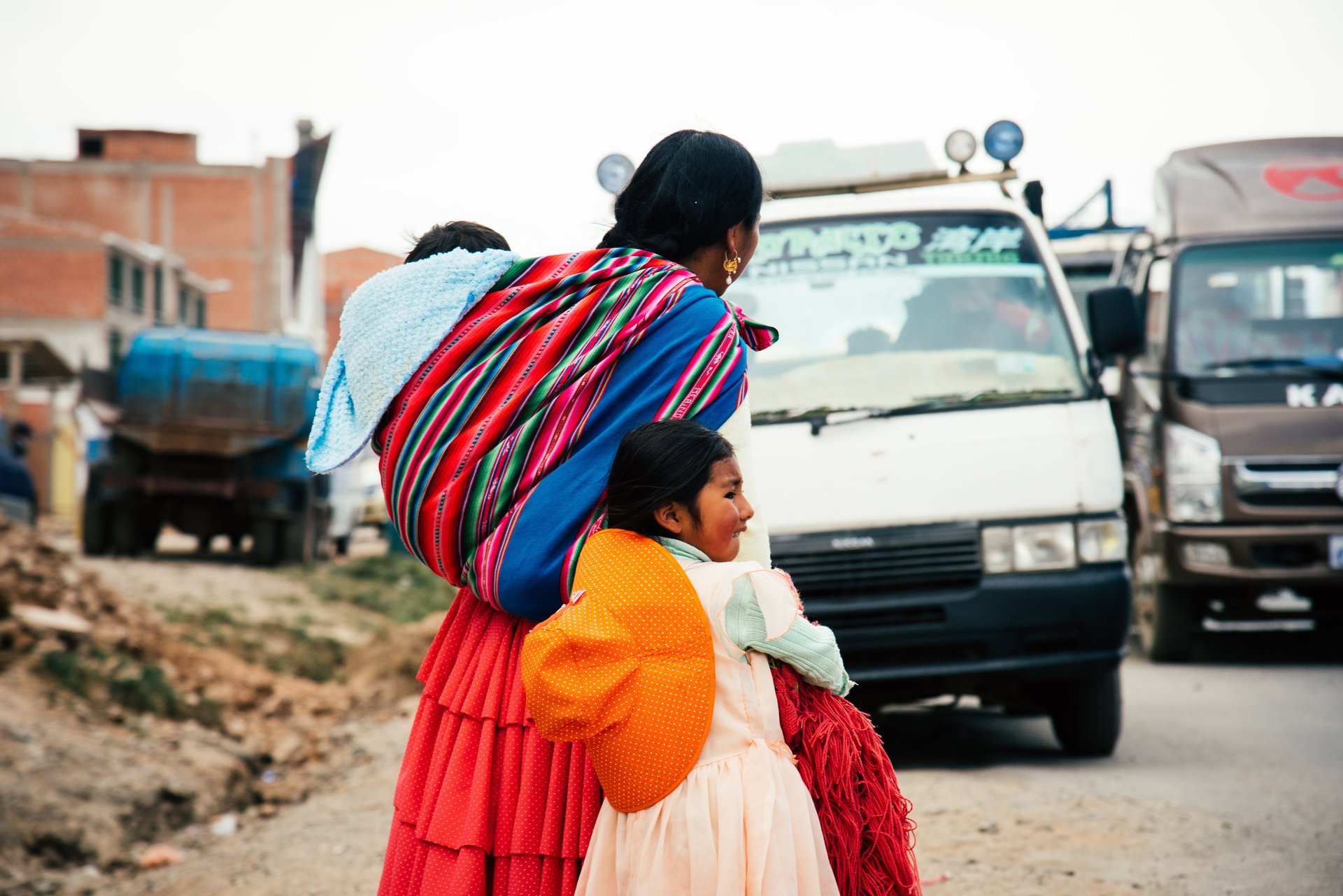Bolivia’s most Instagrammable houses showcase indigenous peoples’ reclaimed power
Carrying a Birkin bag; flashing Triple S sneakers from Balenciaga; arriving late in an Aston Martin. In El Alto, Bolivia, there’s a sign of wealth so large it can’t fit inside a closet or a garage: A building by Freddy Mamani.


Carrying a Birkin bag; flashing Triple S sneakers from Balenciaga; arriving late in an Aston Martin. In El Alto, Bolivia, there’s a sign of wealth so large it can’t fit inside a closet or a garage: A building by Freddy Mamani.
El Alto is a relatively new city. Before 1987, it functioned primarily as a service town to the adjacent La Paz, the highest capital in the world. For the unaccustomed, La Paz can be brutal on the senses: low oxygen levels and low air pressure, and blazing UV exposure during the day with possible freezing temperatures at night. The city lies in a canyon and is structured with the wealthiest neighborhoods lower down, where it’s warmer, instead of higher up, where the views are better, as is common in other cities.

Enter El Alto: a city at 4,000 meters above sea level, even higher up on the altiplano than La Paz. In 1987, it officially became self-governing, and today, it’s the second largest city in the country, with a population of just under one million.
It’s also home for many Aymara, one of the two largest indigenous groups in Bolivia. Three-quarters of El Alto residents identified as Aymara in 2001. Buildings by the architect Mamani are, for El Alto’s wealthy Aymara, an expression of cultural pride after centuries of oppression and racism. At the same time, the buildings add bold, futuristic façades to the streets—and help shape the aesthetic identity of this rapidly growing city. In 15 years, Mamani has built more than 100 buildings in this style: A bona fide architectural trend is flourishing.
Bright returns
Mamani’s buildings are nicknamed “cholets,” a portmanteau made of the high-class “chalets” (as in, Swiss cottages with eaves) and the derogatory “cholo” (as in, racist slang for an indigenous person). Inspired by the brightly colored aguayo cloth used by indigenous women in the Andes, the buildings stand out against the cold, gray environs and the dusty, drab brick buildings of El Alto. They’re soaring lime and emerald, salmon and raspberry, with geometric panels and windows like mirrors.
Inside, they’re loud and maximal, with swirling ceiling fixtures that appear as if riveted by brass studs, circling massive chandeliers. In one cholet, a spider web lined with neon lights spreads across the ceiling. In another, rows of green diamond shapes run wall to wall.
But cholets are more than just outlandish buildings with zany colors; they come with the promise of financial returns. In a typical cholet, the ground floor contains stalls that can be rented out to businesses; the second and third floors house a party venue; and on the upper floors are residential apartments.
“For me, of course it represents the colors of our culture, but mainly it’s the result of hard work,” says Joaquin Quispe Condori, a restaurateur who co-owns a cholet with a salon called El Crucero del Sur, with his siblings, “I believe that we are really hard workers, and all the effort, it’s [shown] here.”

For Condori, who has been working since he was 12 years old, the building is a physical display, something to show for decades of routinely long work days.
Indeed, Aymara have earned a reputation as industrious and enterprising. “We work Monday to Monday,” says Rene Callisaya Apaza, the owner of a cholet whose salon is called Estrella d’Oro.
“When [my children] come, when there’s a party, everybody’s working,” says Fany Elia Tinini de Fosarico, who co-owns a cholet with the salon Fanelia. She describes the scene: She sells presents on the ground level, the kids sell candy, and her husband sells beer.
Cholets are expensive to construct—between $200,000 and $500,000–but not inconceivable compared to standards in the adjacent capital city, and the goal for owners is to rent out space to make back the cost and eventually turn a profit. A cholet is a reward for hard work—that also creates more work.
A revolution on paper
Freddy Mamani Silvestre moved with his family to El Alto at the age of 13 and began helping out with construction. In college he studied civil engineering and didn’t formally study architecture until after his cholets took off. Mamani finished the first of the buildings that would earn this nickname in 2005.
That same year a monumental shift happened in the country: Bolivia elected its first indigenous president. It’s estimated that somewhere between 40 and 60% of Bolivians today identify as being of indigenous ancestry. Yet until 1952, voting restrictions kept some hundreds of thousands of illiterate indigenous people from voting. Racism by white Bolivians no doubt persists today, but the election of Evo Morales ushered in a massive and symbolic change for the country.

In 2009, under Morales’ administration, the country voted for a new constitution that recognized Bolivia as a plurinational country made up of 36 groups and their languages. Morales even set up a decolonization vice ministry in his government, whose aim is to strip the country of its racist roots and bring new awareness to its indigenous traditions.
“At that moment when Evo Morales became president, I remember that moment in El Alto; it was almost a revolution,” says Mamani. He decided then to persist with an architecture just for El Alto. “I did it as a cultural, economic, and social assertion through architecture,” he says.
“The idea is to put color in El Alto,” he adds.
This political empowerment has emboldened elite Aymara, who have been gathering wealth for decades as part of Bolivia’s robust informal economy.
“These [buildings] are an expression of de-colonization, because they’re a way to recover and project our culture,” says Félix Cárdenas Aguilar, vice minister of decolonization. “What colonization wanted, or tried, to do before was to kill all expressions of our culture: their language is a language, and we just have a dialect; their religion is a real religion and we just have some beliefs, some superstitions; what they have is art and what we do are just some handmade things; Chopin and Mozart are music, ours is just strange instruments, folkloric music.”
“This architecture we’re talking about is an answer to centuries of mistreatment,” says Guillermo Delgado-P, professor of anthropology at UC Santa Cruz.
Buildings of the establishment
But that condescension toward indigenous aesthetics exists still, even with Mamani’s buildings: “That kind of architecture is not that important in the history of architecture,” says Gaston Gallardo, the former head of the architecture department at Universidad Mayor San Andreas of La Paz. “Basically it’s popular architecture.”
Though Gallardo says he personally respects Mamani and his buildings, he acknowledges that the architecture establishment doesn’t accept them. “The establishment in Bolivia is really, really racist,” says Gallardo.
(That’s why Mamani resisted the name “cholet” at first. His critics called the buildings kitsch, referring to them as “cakes,” and Mamani wanted the buildings to evoke respect. But today the name has gotten so big that it’s become unavoidable, he says.)

And from the indigenous population, too, the cholets have their critics. The El Alto buildings have been commissioned exclusively by Aymara families, and the salons’ association with ostentatious and glammed up Aymara parties, dances, and ways of dressing could flatten expressions from the rest of Bolivia’s many indigenous groups. This could be a form of ethnocide, argues Milton Eyzaguirre Morales, from La Paz’s National Museum of Ethnography and Folklore. Or they risk becoming a superficial spectacle for curious rich kids from La Paz or from outside Bolivia; there’s been at least one electronic music rave thrown in a cholet, and they’re popular spaces for shooting music videos.
Still, the buildings say something powerful for Aymara with means: We’re here, and we won’t be ignored.
Even among the world’s very wealthy, an architectural fad isn’t a common phenomenon; buildings are a big investment and hard to throw away when the next big thing comes along. But cholets are different: They represent empowerment through something functional and aesthetic, a physical manifestation of the will of one group shooting through an entire city and sprouting up all around.
Though indigenous rural exodus has been happening for decades throughout Latin America—in Lima and Guatemala City, for example—so far it seems Mamani’s cholets are a unique cultural phenomenon. They came about from a specific political and cultural moment, combined with years of economic growth concentrated in one city, among hands that have for centuries been oppressed and dismissed as belonging to second-class citizens. Could El Alto’s architecture serve as a model for other countries, or for other racial and ethnic minorities? It’s fun to imagine Oklahoma City peppered with bold native buildings, Detroit with distinctly African American designed buildings, or San Francisco dotted with Chinese American colors; it’s also, in other ways, hard to imagine.
There’s one more thing that makes the cholets unique, and it’s no less important: The wealthy Aymara are not simply moving into the rich neighborhoods of La Paz and assimilating there. They’re staying put in their own city.
“Now I have the restaurant, this place, my daughters are studying here in El Alto, so for the moment, [I’m staying] here,” says Condori when I asked if he’d ever consider living in La Paz. “It’s a sentimental thing with this building – with my mother; it’s the place where I grew up. Now if the business is here, I’m going to stay here.”
Angela Sofia Vargas provided translation.
Be sure to download the Quartz Brief app for iOS to explore our 3D model of El Alto in augmented reality.